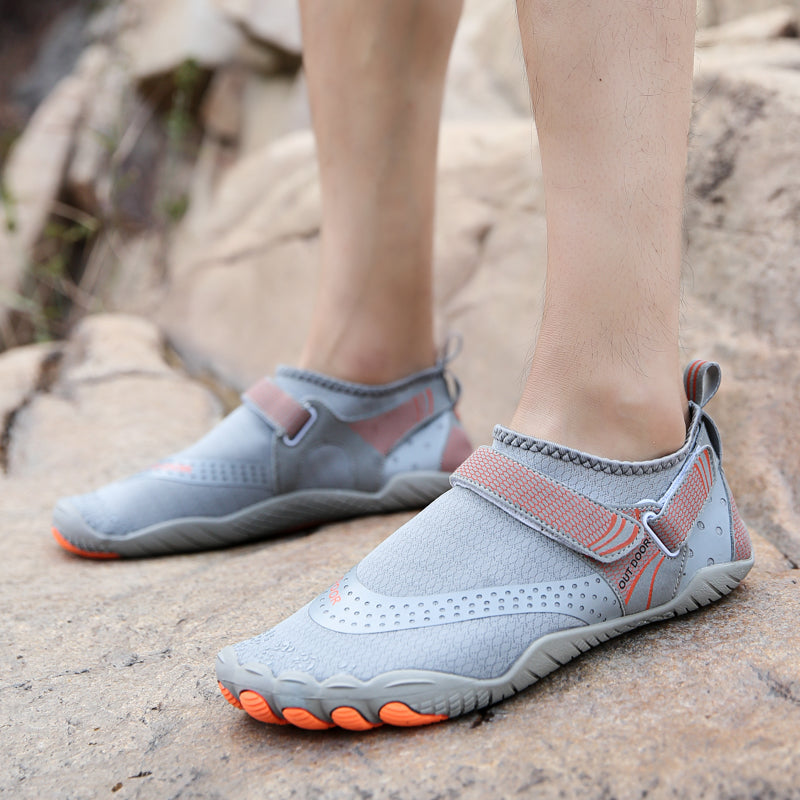Is it time to rethink your footwear? We look at the benefits of going barefoot and reveal how to liberate your feet the sensible way.
The history of running shoes is an interesting one. The thin leather running spikes look that runners used to prefer look vastly different to the shoes you’ll see on the shelves of your local running store now.
As advances in technology and science took hold and running became a mainstream sport, running shoes evolved. We went from the early plimsoll style favoured by the marathon runners of the 1960s to incorporate thick soles designed to support the feet, absorb shock and prevent feet pronating. In fact, as the years passed shoes became bigger, heavier and, in most cases, gave the feet less room to move.
Until some years ago, a research was done which showed the advantages of barefoot running.
This was the start of the barefoot revolution. In a bid to run faster runners started to demand more minimal, lightweight shoes and some even chose to run shoe-free – although the debris of city streets mean this is a brave choice. One school of thought also suggested the more natural movement offered by minimal shoes could help reduce the risk of running injuries.
Running shoe manufacturers soon caught on. Now, alongside cushioned running shoes most shops offer a choice for those who favour a more natural feel. Known as barefoot shoes, these provide protection but with a more natural running experience, similar to running in bare feet but without the danger or getting glass and rocks stuck in your tootsies.
Barefoot shoes have lightweight uppers to reduce weight, wider toe boxes so your toes can spread out, no heel drop so that your body’s alignment isn’t adjusted and a minimal flexible sole that moves with your foot.
The barefoot principles can be used when considering your everyday choice of footwear. The benefit of walking with a barefoot shoe can help to improve flexibility and allow your feet to move more naturally, which will ultimately help when you’re running.
Speaking of benefits, here are four reasons to give barefoot a try.
1. Your balance will improve
If you’re running off road – whether in a park or outdoors – one of the main challenges is the varied terrain. Trying to keep your balance as you traverse between rocks, grass and road can be harder than it looks.
Luckily we have more than just our eyes to help. Our feet are designed to pass sensory information to the brain about what’s underneath us. Padding, heels and cushioning from shoes can all interfere with this perception but the minimal sole of a barefoot shoe allows you to feel the ground and respond to move more skilfully across it.
The wider toe box also means your toes have room to move – our big toe is vitally important for balance.
2. You land more gently
One of the arguments against barefoot running is the shock going through your feet. When our feet strike the ground – whether that’s with your heel, fore- or midfoot – there’s a large amount of force travelling through your body, which over time can cause injury.
However, barefoot specialists say that minimal shoes actually help reduce the impact. If you were to walk on your heels for example, you wouldn’t slam them into the ground as, well, it’d hurt. Whereas cushioning can prevent that initial warning pain so you continue to run heavily, if you’re running in barefoot shoes you’re more likely to adjust your movements to land gently.
3. It can strengthen your lower legs and feet
A study published in the European Journal of Sport Science found that wearing barefoot shoes strengthened the calves and ligaments that wrap around the soles and the arches of the feet, in runners who wore them for 35 percent of their runs. This could be particularly useful if these are problem areas for you.
4. They feel good
You know when you get home from a day at the office or get back after a long training run and all you want to do is kick off those tight shoes? The wider, foot-shaped design of barefoot shoes means your feet and toes have room to spread and move so you should feel less rubbing, cramping and tightness and experience more comfort and freedom.
How to switch to barefoot running shoes
When it comes to moving to barefoot, slow and steady wins the race. If you fancy giving barefoot shoes a go it’s best not to dive in straight away and clock up loads of eager miles in your new footwear. If your feet are used to cushioned or rigid shoes they may be slightly weaker or less flexible than they could be, so build up gradually so as not to cause pain or soreness. Remember for most of your life you’ve probably been wearing shoes that have taught your feet to be lazy and this isn’t going to be changed overnight.
Start by wearing barefoot shoes around the house and for walks and build up to shorter runs. Andune recommends starting out with 10 minutes of exercise wearing barefoot shoes and increasing the duration as you get used to the feel and your foot strength and flexibility improves.
Another way to experience the effect of barefoot first hand is to kick off your shoes and socks and run totally barefoot on a treadmill for a couple minutes. Notice the way your form naturally adjusts to protect from the impact of your feet striking the belt. It’s a great, simple DIY experiment you can do to see how differently you move when your feet do what they’re naturally built to do.



